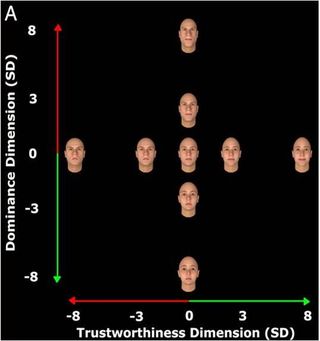First Impressions
How Do Faces Shape First Impressions?
We may assess these two key traits when meeting someone new.
Posted February 26, 2019 Reviewed by Davia Sills

The first impressions we form about other people based on their facial appearance influence important social outcomes. They influence who we choose as friends and lovers, who we choose to hire and fire, and even who we vote for. For example, one recent study found that candidates with more attractive faces performed better in Italian local elections.
We form these impressions extremely rapidly (100 ms is all it takes), and they appear to change after we have interacted with the person. But how does facial appearance shape our first impressions?
Pioneering work on impression formation by Alex Todorov suggests that we assess unfamiliar faces on two main dimensions. One of these dimensions, the valence dimension, appears to reflect our perceptions of that person’s intention to do us harm and is highly correlated with ratings of trustworthiness. The other dimension, the dominance dimension, appears to reflect our perceptions of that person’s ability to do us harm and is highly correlated with ratings of physical strength. The figure below shows these dimensions.

This two-dimensional structure of first impressions was uncovered by first showing U.S. participants face photographs and having them list the personality traits they felt best characterized each person. The faces were then rated for these characteristics and subjected to a statistical technique that reveals the structure underlying the ratings.
The two dimensions that emerged from the analysis were the valence and dominance dimensions described above. While impressions of valence from facial cues do not appear to be particularly accurate, there is good evidence that physical strength can be assessed fairly reliably from facial cues alone.
Has this two-dimensional model of first impressions of faces been replicated in subsequent studies? Sort of. Studies in the UK, including two studies by my colleagues and me, have observed similar patterns of results.
Moreover, a group of voice researchers in the UK found that first impressions of voices were also underpinned by similar valence and dominance dimensions. While the patterns of results observed in these studies were certainly similar to those observed in the original U.S. study, recent work presented by Sally Xie at the 2019 meeting of the Society for Personality and Social Psychology suggests that they may not be as similar as we've argued in the past and are definitely not identical.
Other recent work suggests that valence and dominance are more distinct for judgments of male faces than they are for female faces. Nonetheless, these studies suggest that perceptions of valence and dominance really seem to be key to first impressions, at least in the U.S. and UK.
Many researchers have expressed concern that research in psychological science (and other disciplines) predominantly studies participants in Western cultures. Does the valence-dominance model uncovered by studies of participants in the U.S. and UK apply to other cultures?
Two studies found that Chinese participants assess faces on a valence dimension, just as UK and U.S. participants do. However, rather than assessing faces on dominance, Chinese participants in both studies assessed faces on a competence dimension. This competence dimension appeared to reflect perceptions of intelligence and social status, rather than physical strength.
These results suggest that the valence-dominance model of social judgments of faces does not apply across all cultures. Indeed, other work suggests that different people judge faces in systematically different ways based on their expectations about what traits people tend to share. In which world regions does the valence-dominance model apply?
The Psychological Science Accelerator is a globally distributed network of laboratories (currently over 350 labs from over 45 countries) that coordinates data collection for democratically selected, large-scale studies. It was established and is directed by Chris Chartier. The first study selected to be run through the Psychological Science Accelerator will test more than 9,000 participants to assess how well the valence-dominance model applies to different regions.
This work has been accepted for publication as a Registered Report at the journal Nature Human Behaviour. Registered Reports are a new style of publication where journals assess the rationale for the study, methods, and analysis plan before data are collected, with the aim of neutralizing publication bias. The protocol for this large-scale study is publicly available, and the study is now deep into its data collection phase.
Crowdsourcing research in this way will provide key new insights into how faces shape first impressions and, perhaps more importantly, illuminate the cultural differences and similarities in how this process occurs.




